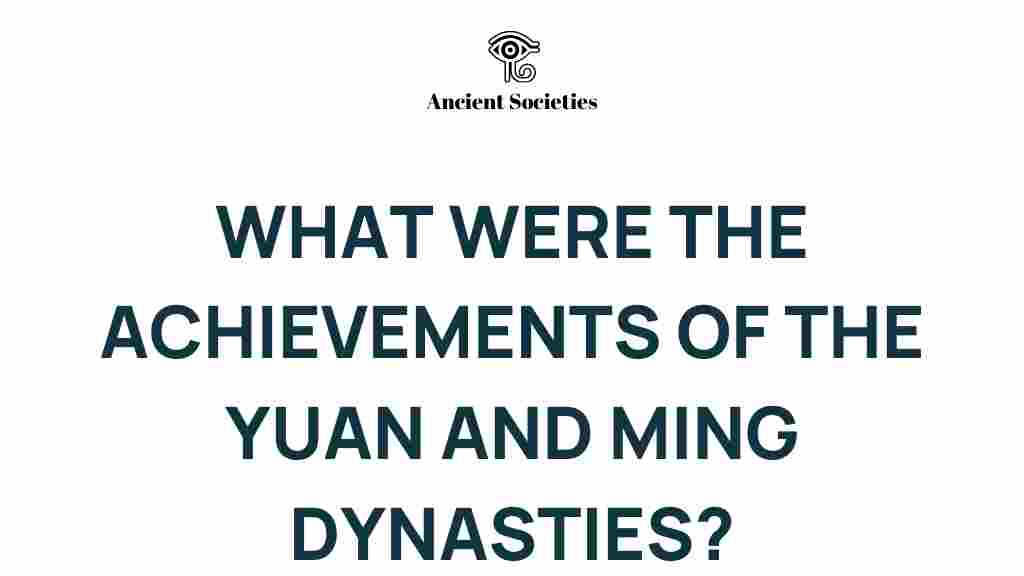Unveiling the Legacy: Achievements of the Yuan and Ming Dynasties in Chinese History
The Yuan Dynasty (1271-1368) and the Ming Dynasty (1368-1644) stand as two of the most significant periods in Chinese history. Both dynasties contributed immensely to the rich tapestry of Chinese culture, technological innovations, and imperial legacy. This article explores their achievements, focusing on cultural accomplishments, technological advancements, trade expansion, and the enduring impact they left on China and the world.
Historical Context of the Yuan and Ming Dynasties
The Yuan Dynasty was established by Kublai Khan, a grandson of Genghis Khan, and marked the first time that non-Han Chinese people ruled over the entirety of China. It was a period characterized by the integration of different cultures and the expansion of trade routes, notably the Silk Road.
Following the Yuan, the Ming Dynasty arose, restoring Han Chinese rule and becoming one of the most prosperous eras in Chinese history. The Ming Dynasty is often remembered for its significant achievements in art, literature, and exploration.
Cultural Achievements of the Yuan Dynasty
The Yuan Dynasty was a melting pot of cultures, which led to remarkable cultural achievements:
- Drama and Literature: The Yuan Dynasty is renowned for its development of Chinese drama, particularly the form known as Yuan Zaju. This theatrical genre combined music, poetry, and performance.
- Art: The period saw the emergence of a unique painting style that included both traditional Chinese techniques and influences from Mongolian culture. Artists like Zhao Mengfu became influential figures in this era.
- Religious Syncretism: With the Mongol influence, various religions such as Buddhism, Daoism, and Islam intermingled, fostering a rich spiritual landscape.
Cultural Achievements of the Ming Dynasty
The cultural achievements of the Ming Dynasty are equally impressive and include:
- Literature: The Ming Dynasty produced some of the most famous novels in Chinese literature, such as Journey to the West and Water Margin, which remain classics to this day.
- Porcelain: Ming porcelain, characterized by its blue and white designs, became highly sought after both within China and internationally, symbolizing the artistic mastery of this period.
- Architecture: The construction of the Forbidden City in Beijing is a testament to the architectural ingenuity of the Ming Dynasty, showcasing the grandeur of imperial power.
Technological Innovations during the Yuan and Ming Dynasties
Both dynasties made significant contributions to technological advancements that would shape Chinese society:
- Yuan Dynasty Innovations:
- Gunpowder Technology: The Yuan period saw advancements in military technology, particularly in the use of gunpowder for weapons.
- Navigation: The Mongol Empire’s vast territory led to improved navigation techniques and maps, facilitating trade and exploration.
- Ming Dynasty Innovations:
- Shipbuilding: The Ming Dynasty is famous for its large treasure ships, which were essential for maritime trade and exploration.
- Printing Technology: The advancement of woodblock printing allowed for the wider dissemination of literature and ideas, profoundly impacting education and culture.
Imperial Legacy of the Yuan and Ming Dynasties
The imperial legacy of both dynasties has influenced subsequent generations in various ways:
- Yuan Dynasty Legacy: The establishment of a multi-ethnic empire set a precedent for cultural integration and tolerance, though it also left behind a complex legacy of resistance and adaptation among the Han Chinese population.
- Ming Dynasty Legacy: The Ming era is often viewed as a high point in Chinese civilization, with its emphasis on Confucian values and bureaucratic governance influencing later dynasties, including the Qing Dynasty.
Trade Expansion during the Yuan and Ming Dynasties
Trade expansion was a hallmark of both the Yuan and Ming Dynasties, greatly facilitating cultural exchange and economic growth:
- Yuan Dynasty Trade: The Mongol Empire’s vast network made trade routes safer and more efficient, leading to increased commerce along the Silk Road. This period saw the exchange of goods, ideas, and technologies between East and West.
- Ming Dynasty Trade: The Ming Dynasty continued to expand trade, especially maritime trade. The voyages of Admiral Zheng He, who led expeditions to Southeast Asia, the Indian Ocean, and beyond, exemplified this expansion.
Art and Literature in the Yuan and Ming Dynasties
Art and literature flourished during both dynasties, reflecting societal values, themes, and innovations:
- Yuan Dynasty Art: Artists began to explore new themes, focusing on landscapes and the human experience, departing from earlier styles that emphasized traditional subjects.
- Ming Dynasty Literature: The Ming era’s literature is marked by a shift towards more accessible narratives, with the rise of the novel as a form, making stories available to a broader audience.
Challenges and Troubleshooting Tips in Understanding the Legacies
While studying the achievements of the Yuan and Ming Dynasties, researchers and enthusiasts may encounter challenges:
- Documentary Gaps: Some historical records may be incomplete or biased. Cross-reference multiple sources for a well-rounded understanding.
- Language Barriers: Original texts are often in classical Chinese, which can be challenging to interpret. Utilize reputable translations and commentaries to aid comprehension.
- Contextual Misunderstandings: Be aware of the historical context to avoid anachronisms in understanding cultural norms and practices. Consulting historical analyses can provide clarity.
Conclusion: Celebrating the Legacy of the Yuan and Ming Dynasties
The Yuan and Ming Dynasties left an indelible mark on Chinese history, with their cultural achievements, technological innovations, and trade expansions shaping not only China but the world at large. Their imperial legacy continues to be felt today, influencing modern Chinese society and beyond.
In conclusion, studying these dynasties offers valuable insights into the evolution of Chinese civilization. For those interested in further exploration of Chinese history, consider visiting this resource for more comprehensive materials. The legacies of the Yuan and Ming Dynasties remind us of the rich cultural heritage and the importance of understanding our historical context.
By appreciating the achievements and challenges of these dynasties, we can better understand the complexities of Chinese history and its lasting influence on global culture.
This article is in the category History and created by AncientSocieties Team
